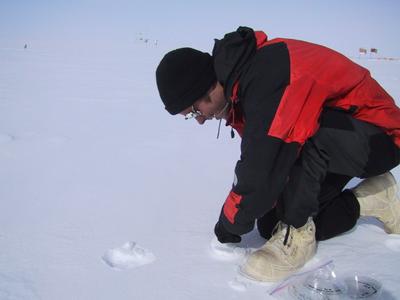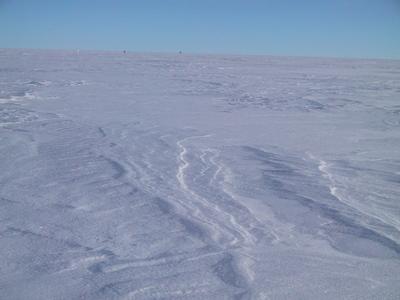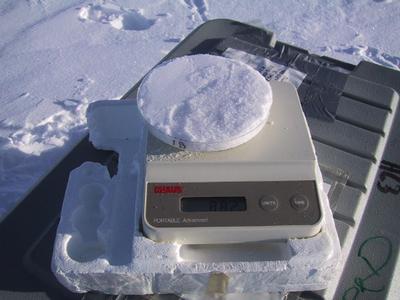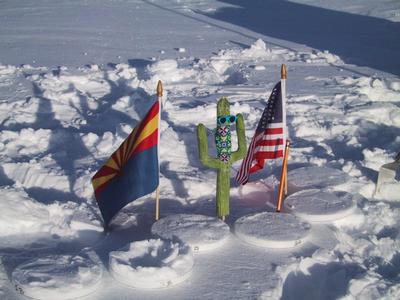
|
21 July, 2001Parallel experiments - Sublimation and Gas Collection There are many science projects going on here at Summit. The scientists working on these projects are from all over the United States and Europe. The experiments, although independent, are also coordinated and parallel. This team effort helps to confirm results and gives the scientists a chance to have many points of view on the topics they are researching. It also creates an atmosphere of synergy and international excitement. For a summary of these experiments check here The snow story I described the snow pit sampling. These snow mini-pit samples tell us what atmospheric gases are trapped in the snow and released by the sun’s energy. These samples are taken many times a day. Snow sampling is one of the procedures that goes on year round here at Summit. ( by some very brave science technicians... I must add...now having done the sampling in relatively nice weather and frozen my hands, knees and toes out there) Snow sampling is usually done twice a week, but since we are running atmospheric tests as well, I will be doing this sampling at least twice a daily, morning and evening. By doing sampling at different times of day in the same locations we can observe how the snow changes over the course of time. These studies are called temporal resolution studies - meaning time dependent. Another way for looking at the snow is to try to observe the differences in the chemistry over a larger area. These experiments, where we collect snow at the same time but in different locations, are known are spacial resolution experiments. On some days we run spacial resolution tests, other days we look at the temporal changes, especially when the air is still and Markus is conducting gradient measurements. Later this summer we will run a 48 hour experiment sampling the snow every three hours to see how the snow changes over a longer period of time. In any case, once the snow is collected it is brought back to the lab to be melted and analyzed. See 1000 bottles of snow for details on this process. Today, Markus and I began a second experiment to measure sublimation and deposition of the snow layer. This data of a more physical nature, the snow's mass, parallels Markus' chemical data, giving him a broader understanding of the snow air system. Keeping up with the 3-5 daily measurements of the masses of these dishes will be part of my responsibilities. I am very curious how it will turn out. This afternoon, we began the experiment by selecting 8 plastic petri dishes and labeling them 1A, 1B through 4A and B. (pairs). This type instrument of measurement has a name, lysimeter. It is commonly used to measure total water balance in an environmental system such as a water shed. Usually these lysimeters are much larger, 10 meters on a side. Since we are using dishes that are only 13 centimeters in diameter, we are calling our petri dishes micro - lysimeters. (pictures below). Once we had the dishes labeled and measured for surface area and volume, we headed out of the science trench area to the clean air zone. The clean air zone is where science experiments are conducted. It is as far away from camp as possible in order to keep the emissions from the generator and camp machinery out of the snow and air samples. We selected a location to place our dishes near a sastrugi or snow drift. Markus was curious how the varying wind and density of the snow in this area would effect the sublimation. We also placed the dishes near to the other experiments in order to keep the character of the snow close to that we are examining for other information. Carefully, the sample dishes were inverted and placed into the snow, then pressed just a little, to better dig into the snow. Once they filled with snow, we gently removed and flipped the snow into another dish to turn the snow right side up again and then set them at snow level. I invented the snow flipping technique - it was like getting a cake out of a cake pan... we were making snow cakes...cooking and science do cross over! Once the snow was right side up and in the dishes we reset them back into the snow at snow level. The idea is to make the snow surface in the dishes as similar to the real snow surface as possible. They are marked with a red flag. I will return to them 3 -5 times a day to observe and weigh them. I plan to coordinate my weather observations with the Swiss team. They take their observations every six hours. More on the Swiss weather here A good day for science experiments, PS... when I did return later tonight the dishes were totally buried since the wind had been blowing all day, causing the snow to drift over the dishes. I could not even find the dishes! I refilled and restarted the experiment, ahh... field science! Update on the petri dish experiment - August 7th, 2001 Now that we have had a series of 6 nice days, this experiment is finally going well. We are seeing the expected daily (or diurnal) variation in the masses of the dishes. Below I have posted a graph of how their masses have changed.
Contact the TEA in the field at . If you cannot connect through your browser, copy the TEA's e-mail address in the "To:" line of your favorite e-mail package. |










